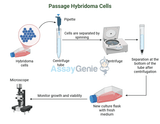Typical Workflow of CRISPR-Cas9 Genome Editing
The CRISPR-Cas9 system is a powerful tool for genome editing, enabling precise modifications to DNA. The typical CRISPR-Cas9 workflow involves several steps, from designing guide RNAs to confirming targeted genetic changes. This guide provides a step-by-step overview of the CRISPR-Cas9 workflow, highlighting best practices for efficient and accurate genome editing.
1. Design of Guide RNA (gRNA)
The first step in the CRISPR-Cas9 workflow is designing a guide RNA (gRNA) that targets the specific DNA sequence for editing.
Key Considerations in gRNA Design
- Target Specificity: Ensure the gRNA sequence is highly specific to the target site to minimize
off-target effects. - PAM Sequence (NGG): Cas9 requires a PAM (Protospacer Adjacent Motif) sequence next to the target site, typically "NGG" for SpCas9.
- Guide Sequence Length: Generally 20 nucleotides long, optimized for Cas9 binding and cleavage efficiency.
Tools for gRNA Design
- Online gRNA Design Tools: Tools like Benchling, CHOPCHOP, and CRISPOR provide options for designing and evaluating gRNAs, including predictions for off-target effects.
2. Synthesis or Cloning of gRNA and Cas9
After designing the guide RNA, the next step is to prepare it alongside Cas9 for delivery.
Methods of gRNA and Cas9 Preparation
- Synthetic gRNA: gRNAs can be ordered as synthetic RNA oligos, which are easy to use and
efficient for transfection. - Plasmid Cloning: Alternatively, gRNA sequences can be cloned into expression plasmids for
cells that require stable Cas9 and gRNA expression. - Cas9 Delivery: Options include Cas9 protein, mRNA, or plasmid DNA, depending on the experiment’s requirements and cell type.
3. Delivery of CRISPR Components into Cells
The CRISPR-Cas9 components are delivered into cells by various transfection methods.
Transfection Methods
- Lipid-Mediated Transfection: Suitable for many cell types, where Cas9 and gRNA are delivered as plasmid DNA or RNA.
- Electroporation: Effective for hard-to-transfect cells, such as primary cells, by directly introducing CRISPR components via electrical pulses.
- Viral Vectors (e.g., Lentivirus): Useful for stable Cas9 expression in cells, particularly for long-term studies and hard-to-transfect cells.
4. Selection and Enrichment of Edited Cells
After transfection, it may be necessary to select or enrich for successfully edited cells.
Selection Techniques
- Antibiotic Selection: For plasmid-based systems with antibiotic resistance, antibiotic treatment can help select edited cells.
- Fluorescence-Activated Cell Sorting (FACS): If a fluorescent marker is included in the construct, FACS can be used to sort transfected cells.
5. Screening and Verification of Edits
Following selection, it is essential to confirm that the CRISPR-Cas9 system successfully edited the target gene.
Screening Techniques
- Polymerase Chain Reaction (PCR): Amplify the target region to screen for edits.
- Restriction Enzyme Digestion: If the edit creates or removes a restriction enzyme site, digestion can confirm successful editing.
- Sequencing: Sanger sequencing or next-generation sequencing (NGS) allows precise confirmation of the edit and detection of off-target mutations.
6. Analysis of CRISPR-Induced Mutations
Analyze the effects of the edit on gene function and cell phenotype to assess the impact of the CRISPR-induced mutation.
Mutation Analysis Techniques
- Western Blotting: Detect protein expression changes due to gene knockouts or knockdowns.
- Quantitative PCR (qPCR): Measure mRNA levels to assess transcriptional changes.
- Functional Assays: Perform assays relevant to the gene’s function (e.g., proliferation assays
for cell cycle genes, apoptosis assays for cell death genes).
7. Documentation and Replication
Properly document the entire process, from gRNA design to mutation analysis, to ensure reproducibility and validation in future experiments. This includes:
- Recording all gRNA sequences and target sites.
- Noting transfection conditions and reagents.
- Storing screening data and results from mutation analysis.
Summary Table: Typical CRISPR-Cas9 Workflow
Step | Description |
|---|---|
gRNA Design | Design specific gRNAs targeting the gene of interest. |
Synthesis/Cloning | Prepare synthetic gRNA or clone into expression plasmids along with Cas9. |
Transfection | Deliver CRISPR components into target cells via appropriate transfection method. |
Selection/Enrichment | Select edited cells using antibiotic selection, FACS, or MACS. |
Screening/Verification | Confirm successful editing with PCR, restriction enzyme digestion, or sequencing. |
Mutation Analysis | Assess gene function changes via qPCR, Western blotting, or functional assays. |
Documentation | Document all protocols, reagents, and results for reproducibility. |
Following each step in the CRISPR-Cas9 workflow ensures precise editing, thorough validation, and reliable results for downstream applications, whether in gene knockout studies, gene therapy, or functional genomics.
Recent Posts
-
Freezing Stimulated T Cells: A Detailed Guide
Cryopreservation of stimulated T cells is a common technique in immunology research, a …6th Nov 2024 -
Typical Workflow of CRISPR-Cas9 Genome Editing
The CRISPR-Cas9 system is a powerful tool for genome editing, enabling precise modific …6th Nov 2024 -
Passaging Hybridoma Cells: A Detailed Guide
Hybridoma cells are essential tools for producing monoclonal antibodies and are derive …5th Nov 2024

